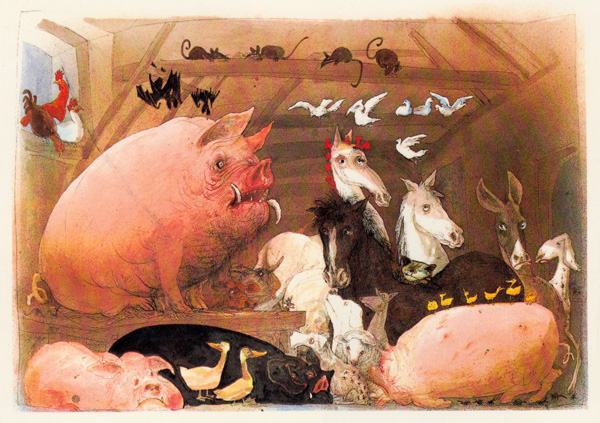We’ve been reading Animal Farm (George Orwell’s self-styled “fairy tale”) for a while now. The residents of Manor Farm have rebelled successfully, ejected the owner and his hired hands, and begun their Utopian society. We introduced the book by briefly discussing the Russian Revolution. Students looked at images of the ill-fated Romanov family and of Marx, Lenin, Trotsky, and Stalin. I gave them a very brief overview of the events between 1917 and the assassination of Trotsky in 1940, focusing primarily on the expectations of what a socialist/communist society could be and what actually took place. We also talked a bit about the difficulty that Orwell had in getting his book published during the mid-1940s in the UK because the British government did not want to alienate the leadership of the Soviet Union (because they were allies at that point in WWII). As newly-named Animal Farm drifts far from the vision originally shared by Old Major (the senior pig at the start of the story), I think there’s going to be a lot of discussion and outrage as the rebellion’s goals are corrupted and a few of the pigs become ruthless exploiters of the rest of the community.

The edition we are reading has large illustrations by Ralph Steadman. Students often comment on his style as we stop to show the pictures.
Several students are very interested in the history connections and ask questions from time to time in order to be sure which of the real people are more or less represented by some of the animals in the story.
_______________
Conferences and conference week are always an interesting break in our usual routines. Most of our students enjoy working intensively on a theme, rather than breaking up the day as we usually do with a schedule of set time blocks for instructional activities and time with specialists. Although we always look for ways to integrate the nominal “subjects” that we teach, conference week sets the schedule aside entirely and uses the days to best advantage.
Conferences are a very valuable and enlightening time for me. The concentrated attention that I can give to each child at this point in the year is helpful in appreciating growth as well as identifying things that need more or different support. The time spent hearing from parents fills out the picture, often helps with planning, and strengthens the ongoing communication between home and classroom.
_______________
Where are we headed next? We will do bridge testing this week at 11:00 on Wednesday. Parents are welcome to attend, of course, but we realize that this is a very inconvenient time for most of you. It is, however, our only whole-group time in the schedule. We sometimes make adjustments in the specialist half-groups that precede it, but we need to get back to our regular activities right now, as we have only 7 days of school before the Thanksgiving break, and we are taking a trip to the Crefeld School on the morning of Nov. 24th to participate in their annual Pioneer Day activities.
We will have students present their bridge research through the coming week and wrap up that part of social studies. When we return from Thanksgiving weekend, we’ll start our big unit on cultures and history in the medieval period (roughly 500 – 1500 CE). Our specific plans are described at length in the letter we sent out to parents in August, and our overall goals for social studies are explained in the curriculum overview (which was sent to you shortly before Back-To-School night in September). The links here take you to our website where those documents can be found.
Our first exploration will be the Mongols because we are going to see the Genghis Khan exhibition at the Franklin Institute on December 14. If you are interested in learning more about them, there is an excellent book that I read recently: Genghis Khan and the Making of the Modern World by Jack Weatherford. Often left out or poorly represented in the history books, the Mongols (especially under Genghis Khan’s 13th century leadership) were important shapers of the military, economic, social, and cultural development of Europe as well as significant parts of Asia.
Franklin Institute on December 14. If you are interested in learning more about them, there is an excellent book that I read recently: Genghis Khan and the Making of the Modern World by Jack Weatherford. Often left out or poorly represented in the history books, the Mongols (especially under Genghis Khan’s 13th century leadership) were important shapers of the military, economic, social, and cultural development of Europe as well as significant parts of Asia.
We’ll be going back in time for some other parts of this multi-part study (which will take us all the way to June), so creating and referring often to a timeline will be one of our ongoing projects. This blog will be a good place for you to follow our journey through the peoples and times in a very large circle around the Mediterranean Sea.
